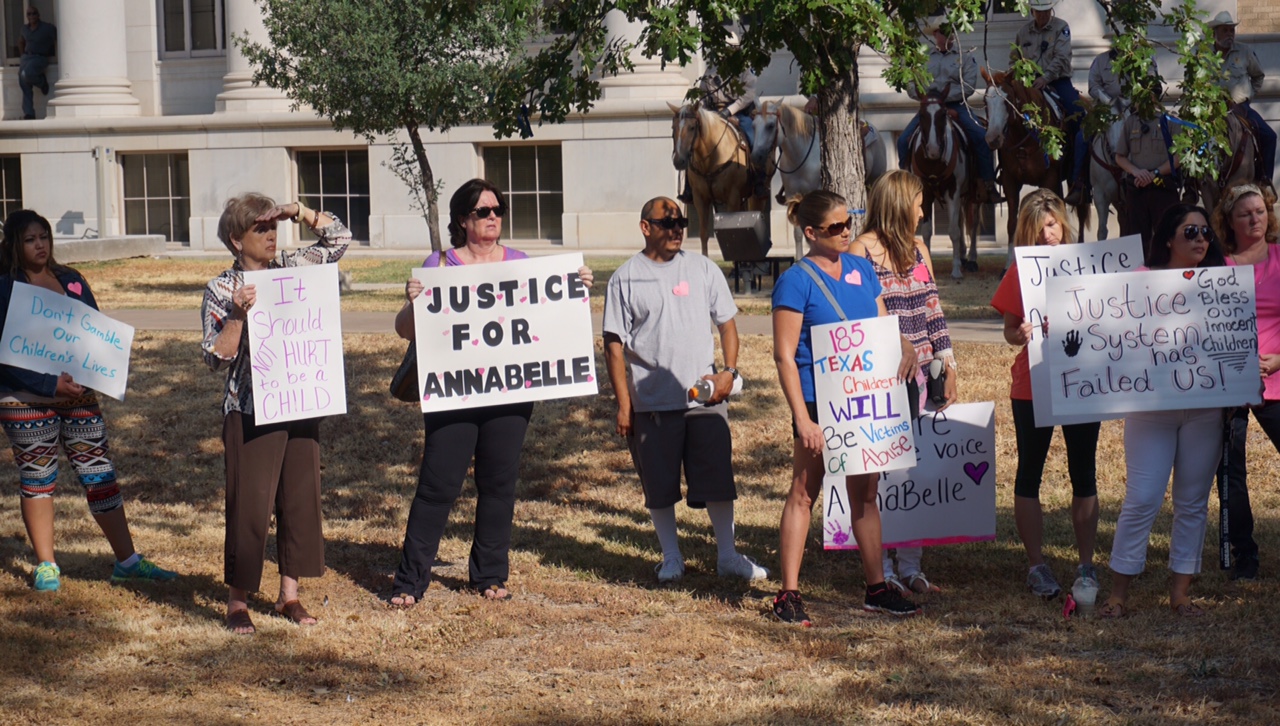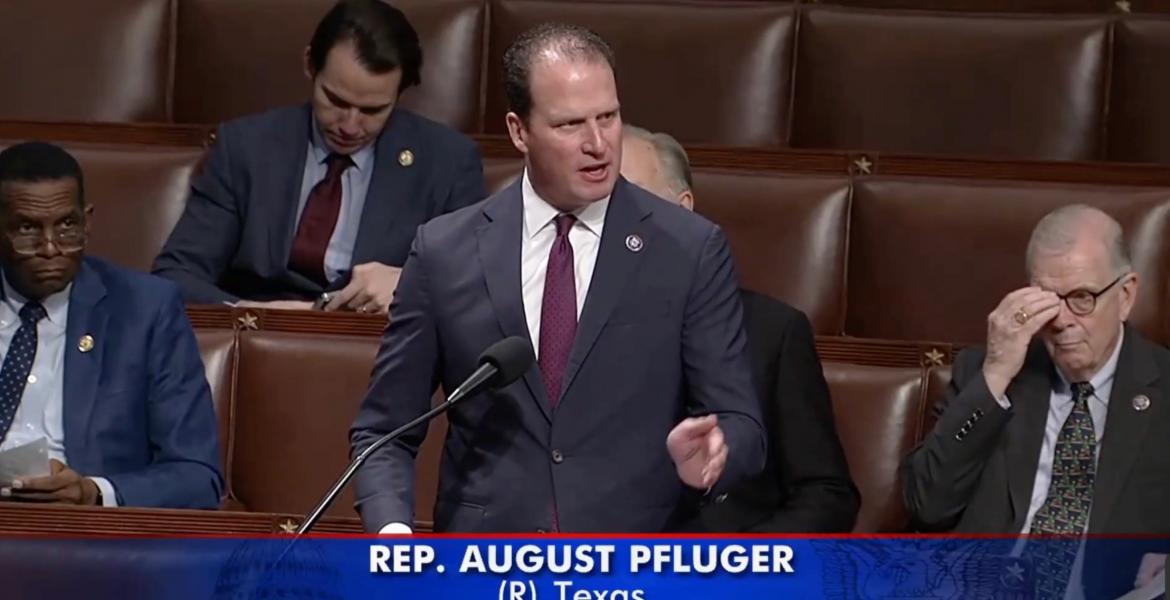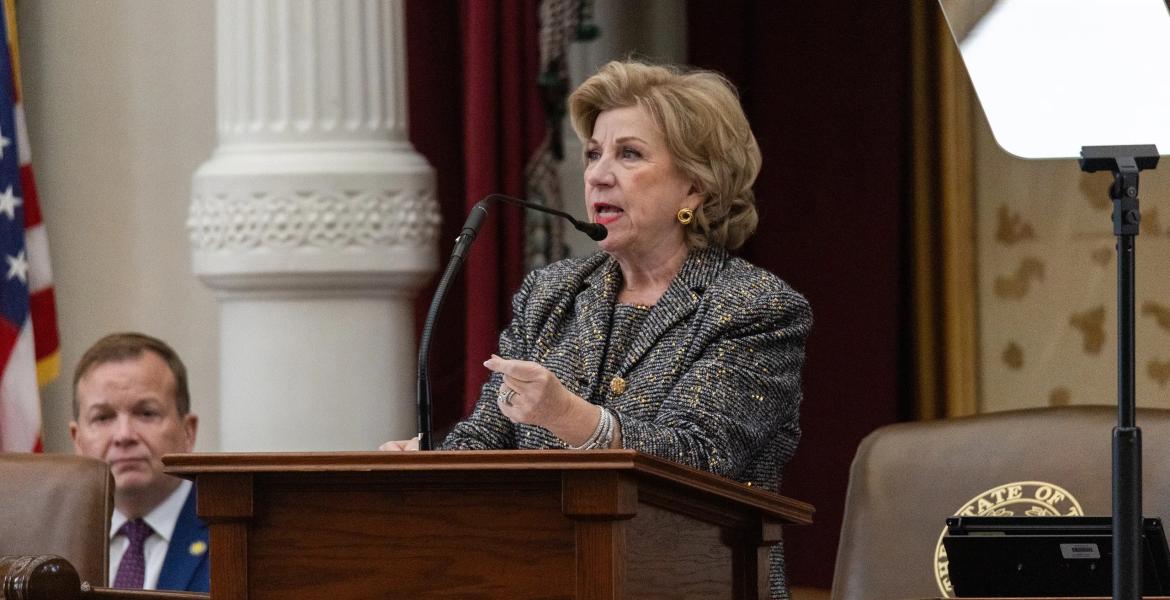When Thomas Boden picked up Brittany Lynn Rosser after work on Jan. 1, 2015, he was highly intoxicated. While driving on the loop, Boden told Rosser, “We all need to die,” and tried yanking the steering wheel, she later reported. Rosser said she managed to stop the vehicle and called 911. While on the phone, Boden got out of the vehicle and began walking home, which was only a few blocks away, Rosser said. When Rosser drove up to her house, there were several San Angelo Police officers who met her and Boden. More showed up over time. Officers detained Boden outside, and while Rosser was inside listening to her children speak to officials, her 2-year-old daughter Annabelle started screaming, “My butt! My butt!” After this, Rosser laid Annabelle down and opened her diaper to find an enormous amount of blood and a clear vaginal tear.
“The officer’s eyes got real big and he tried real hard not to look, but he didn’t know what to do,” Rosser said in a letter written to San Angelo community protesters that was read during the “Justice for Annabelle Protest” held at the Tom Green County Courthouse Monday morning. “I asked Annabelle what happened, and she said, ‘Tom hurt me with his hand.’ I ran outside screaming and crying, pushed by several officers and asked Thomas if he touched my daughter. He didn’t say a word, but had a slight grin on his face.”

After the incident, Annabelle would just cry and cry and tell her mother that she didn’t want to close her eyes. She was terrified and traumatized, her mother said. She didn’t want to see the images in her mind, and she had terrible nightmares. She was scared to death to go to the bathroom because of the pain. Additionally, Annabelle had to have constant physical contact with Rosser for several days. Every second of the day, she had to be touching her. She would go into a panic if she couldn’t see or touch her.
“She seemed so distant when looking into her eyes,” Rosser added. “It was like they were vacant, and she wasn’t there anymore. She wasn’t my Annabelle. She wouldn’t let anyone near her for months, and was very, very angry. She still just cries all the time, even weeks later. Both of my girls went through separate forensic interviews with specialists and testified on record. Annabelle was only two, but she talked really well. I was told they would never have to testify again or go into a court room...Thomas’s statement to the detective when he was arrested was, ‘I was drunk and blacked out. I don’t remember if I did anything.’"
Rosser wrote that Boden never denied what he did, and that today, Annabelle still struggles and has been in counseling for months. She still randomly talks about what happened to her, and certain things trigger her memory and make her panic. It’s been almost eight months since she was violently assaulted by Thomas Boden, but Rosser told protesters, “She deserves Justice, and for someone to fight for her and to protect other children. Please don’t let her voice be taken away just because of her age. Thomas Boden is a monster. I never ever want to witness another mother have to go through what Annabelle has and still does by his hand, and have her innocence stolen and changed forever. Please put this man away before it’s too late. Protect our children.”
After listening to the reading of the letter by Kay Hickey, 50, of San Angelo, who helped organize the Justice for Annabelle Protest,” many of the almost 100 people who attended the protest Monday morning wiped tears from their eyes while others held their signs up higher that read, “Justice for Annabelle,” “Keep Annabelle in Your Prayers,” “Protect Our Children,” and “Together We Stand for Justice.”
Justice, and a change in the way it is pursued here in San Angelo and in Tom Green County, is the message these protesters want to send to all the district attorneys, including Jason Ferguson, who tried Annabelle’s case and who bargained with Boden in a plea arrangement that dropped the aggravated sexual assault of a child charge and one count of indecency with a child including sexual contact in exchange for a guilty plea for injury to a child with serious bodily injury. The deal sent Boden walking with 10 years deferred adjudication probation last Tuesday, Aug. 25.
Following the decision, the San Angelo community not only gathered to rally for change, but some called for Ferguson’s resignation, stating that he had failed Annabelle, Rosser, and their family, by continuing to allow perpetrators like Boden to walk the streets of Tom Green County.
Although Social Agencies Understand, The Reasoning Is Not Good Enough
When Rose Luna, director of communications at the Texas Association Against Sexual Assault (TAASA) based in Austin heard about Annabelle’s case in Tom Green County, she was “disheartened” and didn’t hesitate to join with members of the Concho Valley Rape Crisis Center to come out and support the Justice for Annabelle Protest.
TAASA is a statewide organization committed to ending sexual violence, and it works with local entities and federal agencies to ensure survivors are heard, and to make sure victims of sexual assault have an ally with them as they go through the justice system. For those cases that aren’t taken, TAASA helps the victims to “pick up the pieces as well.”

Annabelle’s case definitely caught TAASA’s attention.
“Once you hear that, it absolutely makes your heart skip a bit. It makes you pause,” Luna said. “It makes you say, 'Here we are in 2015, in a highly civilized society, yet we have no grand jury indictment of a child sexual assault on a 2-year-old child.'” There were two indictments in Boden's case; however, he pled out to a different charge.
Luna says although she understands Ferguson and other district attorneys have a difficult job, and that child sexual assault cases are complex, this is a bigger problem in our society.
“This is a broader issue about how our society views sexual violence,” Luna told protesters and members of the media prior to the beginning of the protest.
Luna also explained how a new prevalent assault study in Texas, which will come out this month, shows that 6.3 million Texans have been sexually assaulted in their lives, and over 90 percent don’t report to law enforcement.
“We have high incidents of sexual assault cases, a low reporting rate, and when they do make it to the justice system, they’re pled out,” Luna stated. “This is not just a law enforcement issue, but rather a society issue.”
Karla Payne, executive director of CVRCC, said the purpose of the protest was not to crucify the DA’s office, or DA Ferguson for that matter; however, Annabelle’s case is an example of the problem in the San Angelo and Tom Green County community.
“What Boden received was almost as bad as him going to trial and receiving no sentence,” she said. Additionally, based on Boden’s plea deal, Payne wonders if the district attorney’s office is doing enough to try these cases.
“Think of someone close to you, a family member or friend. What if that person was a victim? Wouldn’t you want someone to be held accountable?” Payne asked of those who tried Annabelle's case and people at the protest.
She also said that next to murder, sexual assault is the most heinous crime in which a person can be a victim, and she doesn’t understand why this is accepted in the San Angelo community.
“We provided services to 372 people in 2014—372. Those were men, women and children who have been sexually victimized or who were close to someone who have been sexually victimized,” Payne said. “Do we want to give the message that perpetrators of sexual crimes get off scot free, or do we want to give them the message that they aren’t welcome in this city?"
When Payne asked this, protesters yelled back in response, “Not welcome in this city!”
Payne finalized her discussion by saying, “I want to challenge our DA’s office to try more sexual assault cases. Just try. You may lose some, but what if we start putting these criminals in jail? Let’s be the ones who are leading the state in prosecuting and convicting these sex offenders”
Another member of the CVRCC, Crystal Garcia-Ward, director of community outreach and engagement, said no family should have to know what it’s like to organize a protest for a victim, and that sexual assault in our community and our country is preventable.
“Sexual violence is a health crisis, and we have to do everything we can to keep our community members safe. If our children are vulnerable, how are they going to grow into healthy adults?” Garcia-Ward asked.
She added that there are no barriers to bring this education to all communities, and communities that support sexual violence are directly correlated with the inability to stop this crime
“We must continue to mobilize for change because it is possible,” Garcia-Ward proclaimed. “Sexual assault is preventable. It does not have to be the norm in Tom Green County.”
The Fight for Tom Green County and the San Angelo Community
Allison Gilley, who put the protest together after noticing people talking about doing so, said she was happy with the turnout Monday, but she had expected a higher attendance rate. In fact, many protesters out there said they were disappointed at all the people who said they would be there, but didn’t show up.
Started via a Facebook event that boasted 1,000 individuals promising attendance, around 100 showed up on the courthouse lawn Monday morning, armed with posters and signs.
Gilley, however, said, “I think it’s a great turnout still. Any support is needed and much appreciated.”

Gilley added that she is expecting to have her first child soon, and all she keeps thinking about is Boden walking free on the streets.
“That puts my baby in danger. It puts everyone’s child in danger. After talking to the family, the mother, and the aunt, I still don’t understand that this man is on the streets,” Gilley said.
She also said that the family told her that Ferguson said he tried to contact Rosser and her family about the plea deal because they had moved, but that was untrue, and he hasn’t tried to contact them at all. Ferguson, however, still states that he did indeed attempt to contact the family.
As for the other protesters, even if Ferguson is telling the truth, they have no longer have faith in his word. Many of the people out at the protest were also victims of child sexual abuse, or have family members who were victims.
Rose Barrientes, of San Angelo, told the story about how her two daughters, who were 4 and 8 at the time, were raped while in her ex-husband’s home by someone he knew; however, they didn’t tell her until they were older. Although her older daughter was able to move on and became a nurse, her younger daughter is on the streets in Tulsa, Oklahoma.
“We have no way of contacting her,” she told protesters with tears streaming down her face. “She has to be around somebody, and it’s always the wrong person.”
When she heard Annabelle’s story, Barrientes said, “This should never happen. I have a 2-year-old grandson and a 2-week old, and I watch them every second. I’m afraid to leave them in daycare, and I’m afraid to let anyone watch them. It’s affected every aspect of my life. I hope somebody listens and the judges listen. If it was someone in their family, something would have been done. You see they’re watching us (she points to members of the Tom Green County Sheriff’s Office who patrolled the protest)? They should be watching him!”
Unfortunately, for victims like Barrientes’ daughter, drug addiction is a common side effect of abuse.
“The problem with our system is that victims will turn to drugs because we need somewhere to put our heads, but then the system puts us in jail for doing the drugs and fails to understand that it’s the system that got us twisted up in the first place," said Regina Torres, 45, of San Angelo.
Torres was raped from the age of 7 to 11 by a family member, and he only served two years.
“Things have to change. People need to get out and vote, and call their congressman,” she added.
Tom Kelley was also raped from the age of 7 to 11, and he said, “No one believed me when I came forward.” Kelley told the story of how he has struggled with addiction and mental illness, and works hard every day to get his life together.
For these victims, along with the protesters out at the event, Annabelle or any other child doesn’t deserve this kind of life, and if they have it their way, they will make their voices heard at the polls and on paper when they write State Representative Drew Darby. They also said they’re considering requesting an official investigation into Boden's case by the FBI.
“We will let our voices be heard,” protesters yelled.
Not only will their voices be heard, but protesters said they want people like Ferguson to step down and let someone who will fight for children in the community step up. This mantra was vocalized and repeated after Gilley read a letter from Allison’s aunt, Ashley Springer, that read, “The justice system and DA Ferguson are letting that man walk the streets with our children. It’s not fair that they took the voice of Annabelle away. Let them know what a shameful thing they did to let this man roam the streets. Shame on you, Jason Ferguson.”
At this point, protesters began to yell, “Shame on you, Jason Ferguson!” while others shouted, “It’s time to step down, DA Ferguson!”
For the Good of the Child
This section contributed by Chelsea Reinhard
Amidst cries for his resignation, Assistant District Attorney Jason Ferguson has maintained that the decision he made was a tough one, but was the most secure decision he could have reached to ensure that Boden was not acquitted of all charges.
According to the complaint filed with the case, San Angelo police were dispatched to a residence in the 2900 block of Ricks Drive on Jan. 1 for the report of a domestic disturbance. The call had been made by Brittany Rosser, who reported that she had left her daughter in the care of her boyfriend, Thomas Boden, on that date while she went to work.

When Rosser got off work, Boden showed up at her place of employment with her daughter and other family, but was intoxicated, the complaint states. Rosser later revealed via social media that she drove home. On the way, the two became engaged in an argument and Rosser called the police.
Police officers met Rosser and Boden at a residence on Ricks Drive shortly after the call. While they were dealing with Boden, the complaint states, Rosser changed her daughter’s diaper and noticed a heavy amount of blood inside. She also located another bloody diaper and several bloody wipes.
The baby was taken to the hospital and was examined by a sexual assault nurse examiner, who found a deep and wide laceration into her vagina. According to the report of Dr. Kellog, which was referenced in the complaint, the child had suffered “a recent penetrative trauma into the vagina and is highly concerning for sexual assault, until proven otherwise. This is not an accidental injury or one the child would have caused herself. High likelihood of sexual assault.”
The child was also interviewed by a forensic interviewer at the Children Advocacy Center’s Hope House; however, the date of that interview has not been released publicly. Those interviews typically do not take place immediately after trauma.
As news of the plea bargain spread, repeated mention was made to the forensic interview, which was conducted after the assault but prior to the complaint being filed. Complaints on felony cases must be filed within two days of an arrest on an offense.
According to Rosser, whose own typewritten account was posted and shared on Facebook and at Monday morning’s protest, there was a video of that interview with her daughter, the victim, as well as another interview conducted with the victim’s 4-year-old sibling, who allegedly witnessed the assault. Rosser had also been told of the abuse by her children, she told police.
Rosser’s understanding, as voiced in her online statement, was that her child would never have to testify in court. Several questions then arose on social media about why the interview, the mother’s and the sibling’s accounts were not enough evidence to convict.
Claire Carter, a former prosecutor of 13 years in Tom Green County, who now runs her own private practice as a defense attorney and special prosecutor in Austin, agreed to explain what Texas law says about the rules of evidence and child testimony in cases like the one against Boden. She spoke only about what the law dictates and, aside from being provided the ages of the victim and the witnesses, has no personal knowledge of the case against Boden. Her explanation extends only to the laws that govern testimony and evidence in all cases and was asked to explain the law as an expert who has personally dealt with numerous similar cases in her career of over 20 years.
The crux of the issue in the Boden case centers on the 2-year-old victim’s—and the 4-year-old witness’s—competency to testify in court. Under the Texas Code of Criminal Procedure section 38.072, if child under the age of 14 makes an outcry to a person over the age of 18 of certain criminal acts, including those charged against Boden, the statement made to the first adult, although technically hearsay, is admissible in court. However, the 6th Amendment of the Constitution also guarantees defendants the right to confront their accusers, who in this case was a 2-year-old girl.
“They (the accusers) do need to be available to testify, and a 2-year-old is likely to be unavailable to testify due to likely incompetency,” Carter said. “I would think that that [video of the forensic interview] would not be admissible [as evidence in court]. In order for a child’s testimony to be admissible, the judge would have to determine that a child is competent to testify. I cannot imagine a scenario in which a 2-year-old child would ever be competent to testify.“
In order for children to be deemed competent, they have to be able to understand and accurately recall what happened, be able to relate that to a jury, and be able to understand the moral obligation of telling the truth.
Carter said that in her over 20 years of practicing law, she’s never heard of a 2-year-old being considered competent for trial, cannot conceive of it, and has serious misgivings about even a 4-year-old’s ability to competently to testify. The reasoning, she explained, lies with psychological development.
“The main thing that everybody’s looking for is a fair trial,” Carter said. “Every witness has to be able to give an accurate version of what they saw and what they observed. Psychologically, children who are under a certain age—and age can vary by the child, because there are developmental stages—what the child observes is not necessarily what’s happening. Or what the child takes away from their observations is not always an accurate portrayal of the event. They’re developmentally immature, so by nature they’re not necessarily ‘trustworthy,’ so they don’t make good witnesses for a fair trial.”
Carter said that children, of course, are able to tell the truth, but need to be able to understand the gravity of their words and how truth is perceived by adults and the legal system.
Providing a hypothetical example, Carter proposed that perhaps someone is asked to recall a story that happened six months prior. That person may respond that they were standing in a room when a man, John, walked in. Asked to recall that story for someone else, that person might say that he was standing in a room engaged in conversation with a few other people when John walked in. The facts of what happened haven’t necessarily changed, but the information is different, and a skilled defense attorney would latch on and likely try to impeach the testimony of that person, noting differences in the two stories.
“As an adult, we are going to be almost unable to tell the same story multiple times and have it be the identical story,” Carter said. “A child is going to have an even harder time doing that than an adult is, because we are probably, on some level, conscious of the fact that we are being asked to be consistent.”
Boden’s case was set for trial on the October docket, 10 months after the alleged abuse occurred on Jan. 1. If the jury were to listen to the hearsay statement of the first adult told of the abuse—be it the mother, the aunt or the forensic interviewer, whoever was told first—the defendant, represented by retained defense counsel John Young, would have had a right to cross-examine the victim as the accuser. Recordings of forensic interviews are not admissible in court unless approved by a judge on behalf of the defense to impeach the testimony of a victim or witness whose in-trial testimony conflicts with a previously given statement.
“When we do forensic interviews with children, children are being asked about a certain incident in the past,” Carter said. “And it might have happened yesterday, it might have happened last week, it might have happened last summer, and it might have happened three years ago. Children don’t have the same ability to notice sequencing and passing time that adults do. Children are very rarely able to say, ‘this happened on Sept. 18. They don’t keep track of time that way, especially young children. They know things like, ‘I was in first grade,’ or ‘my teacher was Ms. so-and-so.’ To give a full depiction of the event—including when this happened, which is part of the proof—a child is going to need to be able to tell me the events before and the events after, and where the event happened in relation to the passage of time. And they’re not good at, so it’s a big challenge to a prosecution’s case.”
Thomas Boden was indicted on one count of aggravated sexual assault of a child and one count of indecency with a child, sexual contact. While competency concerns and young children’s difficulty with recalling timelines posed a nearly insurmountable hurdle, the wording of the indictment would have essentially required one of the children to testify in order for the jury to convict.
In the indictment, Boden is charged with causing the penetration of the child’s sexual organ by means of his hand. Because the indictment specifies what caused the penetration, the state, in order to seek a conviction, must prove that Boden’s hand did in fact penetrate the victim.
“Because it says 'hand,' what that means is this child—the child victim—or another person has to be able to say in court, ‘I saw his hand touching this child’s sexual organ,’” Carter explained. “We have to have some direct evidence of how we’re going to prove that element. Somebody has to be able to say that that hand—or a part of that hand—entered the child’s genitalia. Penetration is going to require some entry. Somebody has to be able to say that they saw the defendant’s hand go inside the child’s sexual organ.”
The charge in the indictment is based upon evidence gathered through the investigation, including witness statements and the sexual assault nurse’s findings during the examination. The findings of that nurse are admissible and frequently presented in court, but the evidence is circumstantial and cannot stand alone to prove that Boden’s hand caused the penetrative trauma.
Amidst the uproar over the decision, countless individuals have spoken out about how all perpetrators against children deserve life sentences. The sentiment is strong, but it is also a disqualifier from jury service. During voir dire, or the jury selection process, attorneys spend hours asking questions of a prospective panel in order to determine their ability to be fair and impartial. The two main questions during this process seek to ascertain whether a prospective juror can keep an open mind and weigh all of the evidence to make a determination based solely on the evidence heard, and whether a prospective juror can consider the full range of punishment, which may range from probation up to 99 years. Those who cannot are struck from the jury panel and sent home, as inclusion in the trial would deny the defendant his right to a fair and impartial jury.
As both a prosecutor and a defense attorney, Carter said she has a bipartisan perspective of both sides of the legal system, and can see the hurdles facing both state and defense.
“Prosecutors have to weigh whether they want to take a certainty, which is when the defendant pleads guilty to something and he gets supervised, or he pleads not guilty, and we have a trial and we risk not winning that trial,” she said. “Sometimes, the prosecution is saying, ‘this is too important to risk a not guilty verdict.’”
Subscribe to the LIVE! Daily
Required






Comments
Listed By: Lila Dennis
Boden will get his reward, one way or another. Either here on earth or after.
- Log in or register to post comments
PermalinkListed By: Ada Bennett
i am seeing street justice for this scum in his near future
- Log in or register to post comments
PermalinkListed By: Lila Dennis
You dont get so drunk you don't know if you did something to a sweet inocent little child. I hope someone casterates this sorry you know what!!!
- Log in or register to post comments
PermalinkListed By: Lynda Tyler
Maybe next time this will happen to a child of the justice system, then we will see what could have happened to Boden! It's all BS!
- Log in or register to post comments
PermalinkListed By: Lola Rodrigo
What I don't understand is why only 10 years of probation was offered, why not 10 years of prison time??? Now this man is free to harm another child and doesn't even have to register as a sex offender. I hope he never comes around any of your children or mine. You didn't win this case.
- Log in or register to post comments
PermalinkListed By: Karen Freeman
My question to Ms. Carter is simply this, ARE YOU KIDDING ME? THE PHYSICAL EVIDENCE CONFIRMS WHAT A 2 AND 4 YEAR OLD ARE TELLING THE AUTHORITIES. WHAT 2 OR 4 YEAR OLD WOULD KNOW TO SAY THESE THINGS? SHOULDN'T THAT ALONE MAKE HER COMPETENT? There is NO excuse, aka law, should support or even support this type of injustice. The powers that be, attorneys, congressman, respresentatives, judges, etc should be educating the public on how to change these so called laws. Where is society's consciousness, humanity and knowledge of right vs. wrong. Where were the detectives and doctors and local business owners? The entire community should have closed this town and been present at the protest. I am disgusted. Yes, I am an enraged mother. But that is not what this is about. This is about society's responsibility to our children, our future. Just like the piece of garbage that killed my baby girl should not have been out in society, this piece of garbage should also have been locked away. The mother is not you blame. YOU ARE TO BLAME. When it becomes a personal experience for you, and it will, I am afraid that I won't be available to support your cry for justice. We need to stand together as a HUMAN SOCIETY, led by the representatives of the law in getting these laws changed. HOW COULD ANYONE LOOK AT THAT BABY'S FACE AND NOT BE ENRAGED? I hope that the injustice she received, after being encouraged by society to report abuse to the authorities, enrages every citizen in the United States. Why isn't this on the national news? I hope that every law enforcement officer, bails bondsman, attorney and judge are able to look themselves in the mirror. They are ultimately to blame for allowing this injustice. As a nurse, it is my responsibility to not only provide care for my patients, but to also educate them on there disease and the management of that disease. I hope that there is justice for Annabelle and the other citizens that have been excused by "the laws".
- Log in or register to post comments
PermalinkListed By: Rosanne Girton
If they couldn't use her testimony, why bother interviewing her? Two-year-old murder victims aren't available to testify, but their killers are often caught... run forensics on the bloody diapers and wipes, and what is collected during the physical exam, and see if the guy's DNA is on any of it. To be graphic, an act as described by the examiner probably would have left tissue under his nails, and might have left his skin cells or something with his DNA, where it shouldn't have been, on her.
- Log in or register to post comments
PermalinkPost a comment to this article here: